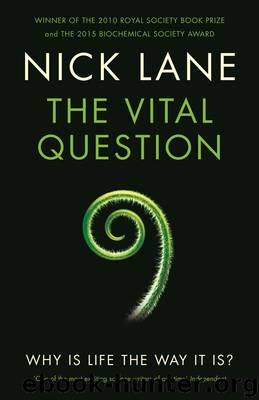1781250367 (B) by Nick Lane

Author:Nick Lane [Lane, Nick]
Language: eng
Format: epub
Tags: Non-Fiction
ISBN: 9781847658807
Publisher: Profile Books
Published: 2015-04-23T07:00:00+00:00
Mitochondria – key to complexity
It’s not obvious why mitochondria always retain a handful of genes. Hundreds of genes encoding mitochondrial proteins were transferred to the nucleus early in eukaryotic evolution. Their protein products are now made externally in the cytosol, before being imported into the mitochondria. Yet a small group of genes, encoding respiratory proteins, invariably remained in the mitochondria. Why? The standard textbook Molecular Biology of the Cell states: ‘We cannot think of compelling reasons why the proteins made in the mitochondria and chloroplasts should be made there, rather than in the cytosol.’ That same sentence appears in the 2008, 2002, 1992 and 1983 editions; one is entitled to wonder how much the authors did actually think about the question.
From the standpoint of eukaryotic origins, it seems to me there are two possible types of answer – trivial, or necessary. When I say ‘trivial’ I don’t mean that in a trivial sense – I mean that there is no unmodifiable biophysical reason for the mitochondrial genes to remain where they are. The fact that they have not moved is not because they can’t move, but because for historical reasons they simply have not. Trivial answers explain why genes stayed in the mitochondria: they could have moved to the nucleus, but the balance of chance and selective forces meant that some of them remained where they had always been. Possible reasons include the size and hydrophobicity of mitochondrial proteins, or minor alterations in the genetic code. In principle, the ‘trivial’ hypothesis argues, all the remaining mitochondrial genes could be transferred to the nucleus, albeit requiring a little genetic engineering to modify their sequence as necessary, and the cell would work perfectly well. There are some researchers actively working on transferring mitochondrial genes to the nucleus, on the basis that such a transfer could prevent ageing (more on that in Chapter 7). This is a problem beset with challenges, not a trivial undertaking in the colloquial use of the term; but it is trivial in the sense that these researchers believe there is no need for genes to remain in the mitochondria. They think that there are real benefits to transferring them to the nucleus. Good luck to them.
I disagree with their reasoning. The ‘necessary’ hypothesis argues that mitochondria have retained genes because they need genes – without them, mitochondria could not exist at all. The cause is unmodifiable: it is not possible to transfer these genes to the nucleus even in principle. Why not? The answer, in my view, comes from John Allen, a biochemist and long-standing colleague. I believe his answer not because he is a friend; quite the reverse. We became friends in part because I believe his answer. Allen has a fertile mind and has put forward a number of original hypotheses, which he has spent decades testing and some of which we have been arguing about for years. In this particular case, he has good evidence supporting the argument that mitochondria (and chloroplasts, for similar reasons) have retained genes because they are needed to control chemiosmotic coupling.
Download
This site does not store any files on its server. We only index and link to content provided by other sites. Please contact the content providers to delete copyright contents if any and email us, we'll remove relevant links or contents immediately.
| Cell Biology | Developmental Biology |
| Entomology | Marine Biology |
| Microbiology | Molecular Biology |
| Biostatistics |
Sapiens: A Brief History of Humankind by Yuval Noah Harari(14327)
The Tidewater Tales by John Barth(12629)
Mastermind: How to Think Like Sherlock Holmes by Maria Konnikova(7281)
Do No Harm Stories of Life, Death and Brain Surgery by Henry Marsh(6910)
The Thirst by Nesbo Jo(6882)
Why We Sleep: Unlocking the Power of Sleep and Dreams by Matthew Walker(6661)
Life 3.0: Being Human in the Age of Artificial Intelligence by Tegmark Max(5520)
Sapiens by Yuval Noah Harari(5328)
The Longevity Diet by Valter Longo(5044)
The Body: A Guide for Occupants by Bill Bryson(5035)
The Rules Do Not Apply by Ariel Levy(4913)
The Immortal Life of Henrietta Lacks by Rebecca Skloot(4552)
Animal Frequency by Melissa Alvarez(4431)
Why We Sleep by Matthew Walker(4397)
The Hacking of the American Mind by Robert H. Lustig(4342)
Yoga Anatomy by Kaminoff Leslie(4336)
All Creatures Great and Small by James Herriot(4277)
Double Down (Diary of a Wimpy Kid Book 11) by Jeff Kinney(4245)
Embedded Programming with Modern C++ Cookbook by Igor Viarheichyk(4145)
